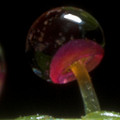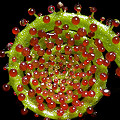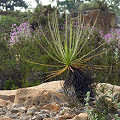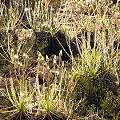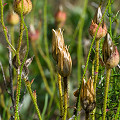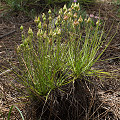Q: Drosophyllum: range and conservation status
A: Drosophyllum is a rarity among carnivorous plants
in that it grows in relatively arid, Mediterranean-climate conditions. It tends to grow on mostly barren, rocky hillsides, south-facing
slopes, and
areas with significant amounts of disturbance.
Most of the populations are found in coastal Portugal, from north of Porto southwards to the Gulf of Cádiz. Additional populations
occur 200 km (125 miles) further to the east. Scattered Spanish sites occur southwards to near the Straits of Gibraltar and at least
one population occurs on the extreme northern tip of Morocco. One Portuguese population is far from the others--200 km inland--near
Portalegre. It has
been theorized that Drosophyllum may have been introduced to this area by cork oak
harvesters. I am fascinated by this hypothesis, since Drosophyllum seeds are large and poorly adapted for
dispersal. Do cork oak workers have extremely muddy boots?
Information that I have on the conservation status of Drosophyllum seems conflicting. Since the plant
apparently occurs in small, separated sites, each individual site is at risk although the species as a whole might be more secure in
the wild. Despite frequent reports to the contrary,
Drosophyllum is not listed on the IUCN Red List of Threatened Species, although it might be on
other threatened species lists. Does anyone have a citation for such a list?
The primary sources of stress are habitat development and damage from military practice. Invasion by the non-native legume
Acacia dealbata is also a threat. Reports suggest that, overall, plant populations are rapidly giving way to
habitat development, but some populations exist in protected habitats.
Page citations: Correia, E. & Freitas, H. 2002;
Garrido, B. et al. 2003; Harshberger, J.W. 1925;
Hilton-Taylor, C. 2000; Juniper, B.E. et al. 1989; McPherson, S. 2010; Rice, B.A. 2006a.
